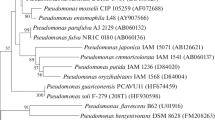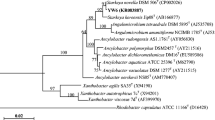Abstract
Azospirillum sp. ANK-BI-11 was isolated from petroliferous soil. Glucose, nutrient broth, and sugar acids showed better growth thann-alkanes under aerobic conditions. The utilization of glucose was inhibited in the presence ofn-hexane. Microaerobically, succinic acid, pyruvic acid, and lactic acid were the best C-sources for acetylene reduction, whereas glucose was the best source for growth.n-Dodecane, a nonconventional C-source, also showed good response towards acetylene reduction, although growth was not so pronounced here as with glucose but was equal to that of Na-succinate. Optimum pH and temperature for acetylene reduction were between 7.0 and 8.0 and 30°C, respectively. Scanning electron microscopic studies revealed structural alteration in the shapes and sizes of the cells ofAzospirillum sp. when grown onn-hexane andn-dodecane compared with the cells grown on glucose.
Similar content being viewed by others
Literature Cited
Anthony C, Zatman LJ (1967) The microbial oxidation of methanol. Biochem J 104:960–969
Atlas RM (1981) Microbial degradation of petroleum hydrocarbons: an environmental perspective. Microbiol Rev 45:180–209
Berkum P Van, Bohlool BB (1980) Evaluation of nitrogen fixation by bacteria in association with roots of tropical grasses. Microbiol Rev. 44:491–517
Bont JAM De, Mulder EG (1976) Invalidity of the acetylene reduction assay in alkane-utilizing nitrogen fixing bacteria. Appl Environ Microbiol 31:640–647
Boulton CA, Ratledge C (1983) The physiology of hydrocarbon-utilizing microorganisms. In: Wiseman A (ed) Topics in enzyme and fermentation biotechnology 9. Chichester: Ellis Horwood Limited.
Bushnell LD, Hass HF (1941) The utilization of certain hydrocarbons by microorganisms. J Bacteriol 41:653–672
Conn EE, Stumpf PK (1972) Outlines of biochemistry. New York: John Wiley, pp 404–407
Das A, Mishra AK (1983) Utilization of fructose byAzospirillum brasilense. Can J Microbiol 29:1213–1217
Davis JB (1952) Studies on soil samples from a “Paraffin dirt” bed. Bull Am Assoc Petroleum Geol 36:2186–2188
Davis JB, Coty VF, Stanley JP (1964) Atmospheric nitrogen fixation by methane oxidizing bacteria. J Bacteriol 88:468–472
Dobereiner J, Day JM (1976) Association symbiosis in tropical grasses. Characterization of microorganisms and dinitrogen fixing sites. In: Newton WE, Nyman CJ (eds), Proceedings of the First International Symposium on Nitrogen Fixation, Pullman: Washington State University Press, pp 518–536
Foster JW, Davis RH (1966) A methane dependent coccus with notes on classification and nomencleature of obligate, methane-utilizing bacteria. J Bacteriol 91:1924–1931
Gill CD, Ratledge C (1973) Inhibition of glucose assimilation and transport by n-decane and other n-alkanes inCandida 107. J Gen Microbiol 75:11–22
Ginkel CG Van, Bont JAM De (1986) Isolation and characterization of alkane-utilizingXanthobacter spp. Arch Microbiol 145:403–407
Griffin WM, Traxler RW (1981) Some aspects of hydrocarbon metabolism by Pseudomonas. Dev Industr Microbiol 22:425–435
Harper HJ (1939) The effect of natural gas on the growth of microorganisms and the accumulation of nitrogen and organic matter in the soil. Soil Sci 78:461–466
Kaserer H (1906) Über die Oxydation des Wasserstoffes und des Methans durch Mikroorganismen. Zentr Bakteriol Parasitenk Abt. II 15:573–576
Miguez CB (1986) Lipopolysaccharide changes and cytoplasmic polyphosphate granule accumulation inPseudomonas aeruginosa during growth on hexadecane. Can J Microbiol 32:248–253
Okon, Y, Albrecht SL, Burris RH (1976) Factors affecting growth and nitrogen fixation ofSpirillum lipoferum. J Bacteriol 127:1248–1254
Okon Y, Houchins JP, Albrecht SL, Burris RH (1977) Growth ofSpirillum lipoferum at constant partial pressure of oxygen, and the properties of its nitrogenase in cell-free extracts. J Gen Microbiol 98:87–93
Patel RN, Hou CT, Laskin AI, Felix A, Derelanko P (1983) Oxidation of alkanes by organisms grown on C2-C4 alkanes. J Appl Biochem 5:107–120
Patel RN, Hou CT, Laskin AI, Felix A, Derelanko P (1983) Epoxidation of n-alkanes by organisms grown on gaseous alkanes. J Appl Biochem 5:121–131
Postgate J (1978) Studies in biology, number 92: nitrogen fixation. 25 London: Edward Arnold Limited, pp 10–18
Postgate JR, Hill S (1979) In: Lynch JM, Poole NJ (eds) Microbial ecology, a conceptual approach. Oxford: Blackwell, pp 191–213
Ratledge C (1984) Microbial conversions of alkanes and fatty acids. J Am Chem Soc 61:447–453
Resnick NA, Mortimer RK (1966) Unsaturated fatty acid mutants ofSaccharomyces cerevisiae. J Bacteriol 92:597–600
Schollenberger CJ (1930) Effect of leaking natural gas upon the soil. Soil Sci 29:261–266
Siporin C, Cooney JJ (1976) Inhibition of glucose metabolism by n-hexadecane inCladosporium resinae. J Bacteriol 128:235–241
Sohngen NL (1906) Über Bakterien, welche Methan als Kohlenstoffnahrung und Energiequelle gebrauchen. Zentr Bakteriol Parasitenk Abt II 5:513–517
Stone RW, White AGC, Fenske MB (1940) Microorganisms attacking petroleum and petroleum fractions. J Bacteriol 39:91–92
Tauson VO (1929) The oxidation of benzene hydrocarbon by bacteria. Planta 7:735–757
Teh JS (1975) Glucose transport and its inhibition by short chain n-alkanes inCladosporium resinae. J Bacteriol 122:832–840
Von Bulow JFW, Dobereiner J (1975) Potential for nitrogen fixation in maize genotypes in Brazil. Proc. Natl. Acad Sci USA 72:2389–2393
Walker JD, Coomy JJ (1973) Oxidation ofn-alkanes byCladosporium resinae. J Bacteriol 115:635–639
Author information
Authors and Affiliations
Rights and permissions
About this article
Cite this article
Roy, I., Shukla, S.K. & Mishra, A.K. n-Dodecane as a substrate for nitrogen fixation by an alkane-utilizingAzospirillum sp.. Current Microbiology 16, 303–309 (1988). https://doi.org/10.1007/BF01568536
Issue Date:
DOI: https://doi.org/10.1007/BF01568536




